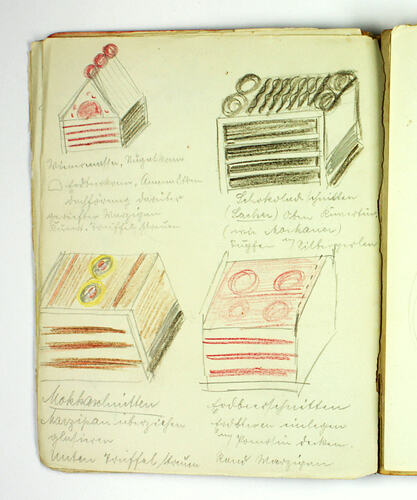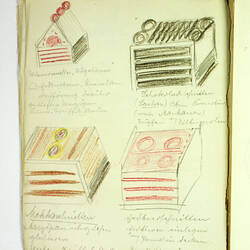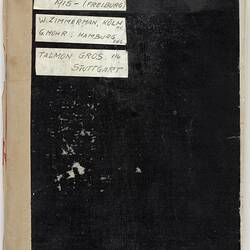Karl Friedrich Muffler was a young German confectionary apprentice when he began to record recipes in a small exercise book, now held in the collection of Museums Victoria (HT 18082). He was living in difficult times: it was 1915, World War I was raging, and he was studying at the Städische Gewerbeschule, a vocational school in Freiburg - right on the French border. Like much of Germany, the town was suffering food shortages and blackouts - and Freiburg was also being bombed.
Nevertheless, Karl carefully recorded key recipes that he would use in his long career, such as tortes, yeasted pastries, puddings and biscuits. The book includes 148 numbered pages, as well as loose-leaf recipes and notes tucked between the pages.
Karl probably wrote his recipe book sequentially, carefully numbering the pages in the main part of the book. His recipes are organised into sections: Tortes, Small Cakes, Tea Pastries, Ice Cream and Cream, Ice Cream Bombe and Cream, Christmas Pastries, Cookie Bars, Yeasted Doughs, All Sorts of Recipes, Assorted Creams, Tortes, War Recipes, Pastry Chef Zimmermann Cologne, Tortes Buttercream, Pastry Shop Mohr Hamburg, Miscellaneous, Pastry Shop Talmon Gros Stuttgart, Ice Cream Bombes and Tortes.
Karl's recipes usually contain ingredients familiar today: flour, sugar, butter and eggs. Some contain ground almonds, grated chocolate and cream. Fruits included apricots, lemons and orange peel. Ingredients less familiar today include green almonds, lees, and ammonium and alum (for leavening).
Karl included a small section of 'war recipes'. Some have substituted ingredients such as the use of potato flour instead of starch and substituting butter with water in the Sand Mixture (German pound cake, p.76) and the use of egg powder to replace eggs in the Linzer (Austrian shortbread, p.76). Yet most of Karl's war recipes are not significantly different to his usual ones - for example the Nuremberg Lebkuchen has 21 egg yolks (p.80), and the Sand Wreath has 2kg of butter and 3kg sugar (p.77), noting of course these are commercial quantities.
Karl provided few cooking directions - occasionally, he'd make notes such as 'pour on a marble top sprinkled with powdered sugar' (Soft Croquants, p.123); 'Do not frost truffles and coat with bitter couverture' (Kaiser Pralines, p.123); and '1 double, 1 simple fold' (pastry for Butterhorns, p.121). He was mostly assuming he'd remember techniques, drawing on much-practised ways of beating eggs, measuring ingredients, choosing the right pans and checking to see if done. Many recipes omit quantities, such as the Spekulatis (spiced shortbread) which simply includes 'cinnamon, cloves and lemon' (p.80).
The visual appearance of food was very important to Karl - it was the hallmark of his profession. He included many detailed drawings of cake and biscuit decorations, such as an elaborate Pilztorte (mushroom cake, P8, p.26 and p.69). Like his cooking directions, though, he recorded few decorating instructions in the book and no specific aesthetic guidelines, preferring brief notes such as 'decorate [with] dominoes and chocolate cream' (Domino Cubes, p.23) and 'decorated with hazelnuts wrapped in marzipan' (Noisette Torte, p.70). Several years later, in 1924, he extended his qualifications with a 'Meisterprüfung im Konditorei handwerk' (Master Certification in Confectionary Handicraft).
Karl's diligence as an apprentice paid off: after the war he was able to find work in quality establishments, and was provided references by each as he left, including Cake Shop Zimmermann, Cologne (1924), Konditorei Ausstellung, Hamburg (1925), Cake Shop Mohr, Hamburg (1926) and Cake Shop Talmon Gros, Stuttgart (1930). Karl added recipes to his book as he worked.
In 1930 Karl left Germany for Melbourne, sponsored by pastry chef Bill Ikinger, with whom he was to work for many years. Karl set up his own business in 1935, but after three years returned to work with Bill, likely because the demands of his own business were overwhelming. Karl's reputation as an innovative and artistic designer continued to grow, and in 1940 the Secretary of the Pastrycooks Union stated 'I would say without any fear of contradiction that he is the best finisher for pastrycooking work in Australia'.
During World War II Karl was interned as an enemy alien. The Pastrycooks Union made appeals for his release, to no avail. After the war Karl returned to work for Bill, who now owned Paterson's Cakes in Windsor, and accepted a position at William Angliss Food Trades School, teaching cake decoration to ex-servicemen. He continued to design cakes well into his later years, even making one for his 50th wedding anniversary when he was almost 90. His passion for creating endured all his life.
In 2021 Museums Victoria curatorial intern Karen Li translated the recipe book from German into English for the first time. The full manuscript is now available online.
More Information
-
Keywords
Immigration, Cultures and histories : Melbourne and Victoria, Military History
-
Localities
Melbourne, Victoria, Australia, Germany, Tatura, Victoria, Australia
-
Authors
-
Article types


